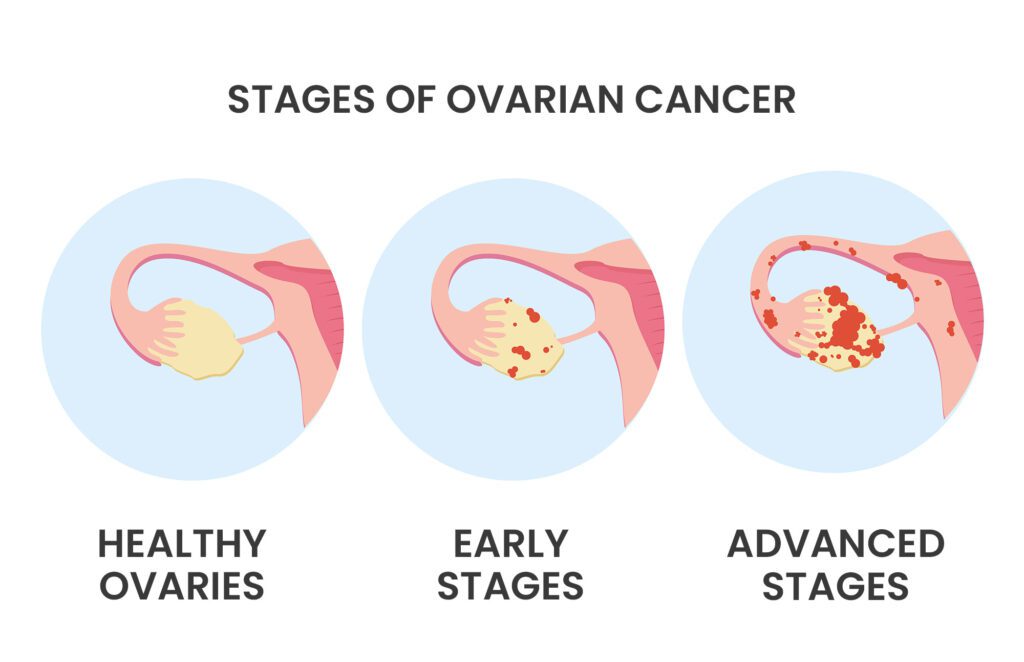Information center / Cancer / Gynecology / Monthly Spotlight / VM Med / Women's health
What are the different stages of ovarian cancer?

(Tina Dawn/ VM Med) — Being diagnosed with ovarian cancer can be a scary and stressful experience. It’s important for a patient to understand what stage of cancer they are facing, how their doctor determines this, and how their medical team expects to plan treatment and predict prognosis based on the cancer’s development.
Oncologists determine a person’s cancer stage using a variety of measurements and results acquired via a series of diagnostic tests, imaging scans, and sometimes samples taken from surgical biopsy. An ovarian cancer ultrasound is also a very useful diagnosis tool. It uses high-frequency sound waves to detect a tumour and see if it’s solid or fluid-filled, as well as to determine the shape and size of the tumour.
Once doctors know where the cancer tumours are located and whether or not it has spread to nearby lymph nodes or other parts of the body, they can then assign a cancer stage of 1-4, ranging from early to advanced. Sometimes, for more accuracy, the stages are also divided by substages, A, B, and C. Basically, the stages refer to the size, location, and extent of the disease, as explained by the Canadian Cancer Society.
Early stages of ovarian cancer
A lower stage generally means that the cancer is more localized and easier to treat, while a higher number indicates that the cancer has spread. Earlier stages of the disease are generally associated with a better prognosis than advanced stage disease.
Stage 1 ovarian cancer usually means that the cancer is confined to the ovary, or ovaries, or the fallopian tubes. It has not spread to nearby lymph nodes. The average five-year survival rate is extremely high at 93%.
Stage 2 ovarian cancer means the cancer is found in one or both ovaries or fallopian tubes and has spread to other pelvic areas. Other signs of stage 2 cancer are when other pelvic tissues show signs of the disease, such as the outer part of the uterus or the pelvic tissue near the ovary. The general 5-year survival rate tends to be around 74%.
Advanced stages of ovarian cancer

If doctors find ovarian cancer in the lymph nodes, they consider it stage 3 because it means the disease has spread beyond the abdominal cavity. Stage 3 ovarian cancer means that the cancer is found in one or both ovaries and has spread outside the pelvis to other parts of the abdomen and/or nearby lymph nodes. Most ovarian cancers are diagnosed at this stage.
Stage 4 ovarian cancer means that the cancer has spread even further beyond the abdominal cavity, to the liver, lungs, and the spleen. Main treatments include surgery and chemotherapy, as well as targeted therapies and immunotherapy. The survival rates tend to be lower at this stage, but many advanced and aggressive treatment options still remain.
Ovarian cancer treatments
Ovarian cancer treatment depends on the stage of cancer a patient is facing. The most common form of treatment is a total abdominal hysterectomy. Usually, a biopsy of the lymph nodes and any adjacent areas is recommended so your doctor can see if the cancer has spread beyond the ovaries. If no further cancer is detected, that confirms the disease is at stage 1. Some patients may require no further treatment, while chemotherapy may also be recommended for some.
Stage 2 ovarian cancer treatment usually involves a hysterectomy and removal of both ovaries and fallopian tubes. Again, a biopsy of the lymph nodes and other tissues in the pelvis and abdomen is undertaken to evaluate for spread of the cancer. After surgery, most patients will also receive chemotherapy.
If doctors find cancer in the lymph nodes (stage 3 ovarian cancer) they will perform surgery to remove all visible signs of cancer. Stage 4 ovarian cancer means the cancer is widespread, and surgery may fail to remove it all. Often, doctors recommend that chemotherapy take place before surgery to shrink the tumour or tumours.
Accurate staging important for treatment
Accurate staging is vital for a patient’s treatment. Being well informed about one’s diagnosis and the course of action to be undertaken can go a long way towards easing concerns and allowing the patient to feel included and informed during every step of the process.
It also allows the medical team to determine the best treatment options available, based on a patient’s specific stage. For example, a stage 1 ovarian cancer diagnosis won’t necessarily require chemotherapy, which is good news for a young cancer patient who wants to preserve their fertility.
Ovarian cancer doesn’t always present symptoms and sometimes the symptoms it does present mimic many other benign afflictions. It’s why ovarian cancer is mostly detected at an advanced stage. If you have a strong family history of ovarian cancer you should inform your healthcare provider, so they perform regular pelvic exams, and follow up with imaging, a transvaginal ultrasound, or blood work.
VM-Med’s private gynecology center and its specialized team offers specialized counselling and treatments on a wide range of issues, including ovarian cancer. There are no questions or concerns that are off the table for your gynecologist.
Still have questions? Read more articles on ovarian cancer or book a consultation with our gynecology experts.
Categories
